C++类和对象(中)【下篇】

🌟个人主页:落叶
🌟当前专栏: C++专栏
目录
赋值运算符重载
运算符重载
赋值运算符重载
日期类实现
运算符重载<和运算符重载==
运算符重载进行复用
运算符重载<=
运算符重载>=
运算符重载>
运算符重载!=
获取某年某月的天数
日期+=或+天数
日期-=或-天数
前置++和后置++
日期-日期
日期类实现代码
Date.h
Date.cpp
test.cpp
运算符重载的(流插入和流提取)
流插入
流提取
取地址运算符重载
const成员函数
取地址运算符重载
赋值运算符重载
运算符重载
- 当运算符被⽤于类类型的对象时,C++语⾔允许我们通过运算符重载的形式指定新的含义。C++规定类类型对象使⽤运算符时,必须转换成调⽤对应运算符重载,若没有对应的运算符重载,则会编译报错。
- 运算符重载是具有特殊名字的函数,他的名字是由operator和后⾯要定义的运算符共同构成。和其他函数⼀样,它也具有其返回类型和参数列表以及函数体。
- 重载运算符函数的参数个数和该运算符作⽤的运算对象数量⼀样多。⼀元运算符有⼀个参数( 如:*/++/-- ),⼆元运算符有两个参数 (如: +/- />/<) ,⼆元运算符的左侧运算对象传给第⼀个参数,右侧运算对象传给第⼆个参数。
- 如果⼀个重载运算符函数是成员函数,则它的第⼀个运算对象默认传给隐式的this指针,因此运算符重载作为成员函数时,参数⽐运算对象少⼀个。
- 运算符重载以后,其优先级和结合性与对应的内置类型运算符保持⼀致。
- 不能通过连接语法中没有的符号来创建新的操作符:⽐如operator@。
- .* :: sizeof ?: . ? 注意以上5个运算符不能重载。(选择题⾥⾯常考,⼤家要记下)
- 重载操作符⾄少有⼀个类类型参数,不能通过运算符重载改变内置类型对象的含义,如: int operator+(int x, int y)
⼀个类需要重载哪些运算符,是看哪些运算符重载后有意义,⽐如Date类(日期类)重载operator-就有意义,日期减去日期可以得到还剩下但是天。
但是重载operator*就没有意义。
- 重载++运算符时,有前置++和后置++,运算符重载函数名都是operator++,⽆法很好的区分。C++规定,后置++重载时,增加⼀个int形参,跟前置++构成函数重载,⽅便区分。
- 重载<<和>>时,需要重载为全局函数,因为重载为成员函数,this指针默认抢占了第⼀个形参位置,第⼀个形参位置是左侧运算对象,调⽤时就变成了 对象<<cout,不符合使⽤习惯和可读性。重载为全局函数把ostream/istream放到第⼀个形参位置就可以了,第⼆个形参位置当类类型对象。
内置类型(int...)这些支持编译器自带的运算符,但是自定义类型(类类型...)这些,就不支持运算符了。
自定义类型,编译器不知道我们定义的自定义类型是什么要干什么。
所以编译器让我们自己根据自定义类型来实现运算符重载。
下面那个代码是比较2个日期类大小,用运算符重载函数(operator和运算符结合)来进行比较。
重载操作符⾄少有⼀个类类型参数,不能通过运算符重载改变内置类型对象的含义,如: int operator+(int x, int y)

重载运算符函数的参数个数和该运算符作⽤的运算对象数量⼀样多。⼀元运算符有⼀个参数( 如:*/++/-- ),⼆元运算符有两个参数 (如: +/- />/<) ,⼆元运算符的左侧运算对象传给第⼀个参数,右侧运算对象传给第⼆个参数。
下面这个代码私有的成员变量,不能被修改,所以会报错,公有就不会报错,也可以重载为成员函数。
#include<iostream>
using namespace std;
class Date
{
public://公有
//全缺省构造函数
Date(int year = 1, int month = 1, int day = 1)
{
_year = year;
_month = month;
_day = day;
}
private:私有
//成员变量
int _year;//年
int _month;//月
int _day;//日
};
//--------------------------------------------------------------------
bool operator<(const Date& x1, const Date& x2)
{
//比较年
if (x1._year < x2._year)
{
return true;
}
//年相等,比较月
else if (x1._year == x2._year && x1._month < x2._month)
{
return true;
}
//年相等,月相等,比较日
else if (x1._year == x2._year && x1._month == x2._month && x1._day < x2._day)
{
return true;
}
//都等于,或大于返回false
return false;
}
int main()
{
Date d1(2024, 9, 2);
Date d2(2024, 7, 4);
//比较,结果给tab
bool tab2 = operator<(d1, d2);
//这样写,编译器会自动转换成operator<(d1, d2),所以这样写比较方便
bool tab = d1 < d2;
cout << tab << endl;
return 0;
}重载为成员函数
重载为成员函数,就不能向上面这样写了。
我们可以看到下面报错了很多。运算符函数参数太多。

如果⼀个重载运算符函数是成员函数,则它的第⼀个运算对象默认传给隐式的this指针,因此运算符重载作为成员函数时,参数⽐运算对象少⼀个。
有隐式的this指针,所以我们不需要显示写d1这个参数。
#include<iostream>
using namespace std;
class Date
{
public:
//全缺省构造函数
Date(int year = 1, int month = 1, int day = 1)
{
_year = year;
_month = month;
_day = day;
}
//不用写第一个参数,第一个参数有隐式的this指针
bool operator<( const Date& x2)
{
//比较年
if (_year < x2._year)
{
return true;
}
//年相等,比较月
else if (_year == x2._year && _month < x2._month)
{
return true;
}
//年相等,月相等,比较日
else if (_year == x2._year && _month == x2._month && _day < x2._day)
{
return true;
}
//都等于,或大于返回false
return false;
}
private:
int _year;//年
int _month;//月
int _day;//日
};
int main()
{
Date d1(2024, 9, 2);
Date d2(2024, 7, 4);
//比较,结果给tab
bool tab2 = d1.operator<(d2);
//这样写编译器会转换成 d1.operator<(d2), 所以这样写比较方便
bool tab = d1 < d2;
cout << tab << endl;
return 0;
}这个d1类里的operator<函数,把d2传过去,这样就可以对2个类进行比较了。

也可以这样写。
//这样写编译器会转换成 d1.operator<(d2), 所以这样写比较方便
bool tab = d1 < d2;我们可以看到它们在汇编,都是一样的。

.* :: sizeof ?: . ? 注意以上5个运算符不能重载。(选择题⾥⾯常考,⼤家要记下)。
class A
{
public:
//成员函数
void func()
{
cout << "A::func()" << endl;
}
};
typedef void(A::* PF)(); //成员函数指针类型
int main()
{
// C++规定成员函数要加&才能取到函数指针
PF pf = &A::func;
A obj; //定义ob类对象temp
// 对象调⽤成员函数指针时,使⽤.*运算符
(obj.*pf)();
return 0;
}重载操作符⾄少有⼀个类类型参数,不能通过运算符重载改变内置类型对象的含义,如: int operator+(int x, int y)
// 编译报错:“operator +”必须⾄少有⼀个类类型的形参
int operator+(int x, int y)
{
return x - y;
}重载++运算符时,有前置++和后置++,运算符重载函数名都是operator++,⽆法很好的区分。C++规定,后置++重载时,增加⼀个int形参,跟前置++构成函数重载,⽅便区分。
+=运算符重载后面会讲,假设我们已经把+=运算符实现好了。
前置++,没有任何参数,使用+=运算符重载加1后,出了作用域,d1还在所以使用引用返回,传值返回也行,就是会调用拷贝构造。
后置++,必须有一个int形参,⽅便和前置++区分,后置++将d1拷贝给tab,使用+=运算符重载加1后,
这tab是在作用域创建的,出了作用域就销毁了,不能使用引用返回了,使用传值返回,把tab的数值返回。
class Date
{
public:
//全缺省构造函数
Date(int year = 1, int month = 1, int day = 1)
{
_year = year;
_month = month;
_day = day;
}
//+=运算符重载,实现后面会讲,现在假设已经把+=运算符实现好了
Date operator+=(int day)
{
//..........
}
//++d
//前置++,编译器会自动转换成 d1.operator++()
Date& operator++()
{
//使用+=运算符重载+1
*this += 1;
//返回d1引用
return *this;
}
//d++
//后置++,编译器会自动转换成 d1.operator++(0)
Date operator++(int)
{
//d1拷贝给tab
Date tab(*this);
//使用+=运算符重载+1
*this += 1;
//返回tab的值
return tab;
}
private:
int _year;//年
int _month;//月
int _day;//日
};
int main()
{
Date d1(2024, 1, 1);
//前置++,会自动转换成 d1.operator++()
++d1;
//后置++,编译器会自动转换成 d1.operator++(0)
d1++;
return 0;
}赋值运算符重载
赋值运算符重载是⼀个默认成员函数,⽤于完成两个已经存在的对象直接的拷⻉赋值,这⾥要注意跟拷⻉构造区分,拷⻉构造⽤于⼀个对象拷⻉初始化给另⼀个要创建的对象。
赋值运算符重载的特点:
- 赋值运算符重载是⼀个运算符重载,规定必须重载为成员函数。赋值运算重载的参数建议写成const 当前类类型引⽤,否则会传值传参会有拷⻉。
- 有返回值,且建议写成当前类类型引⽤,引⽤返回可以提⾼效率,有返回值⽬的是为了⽀持连续赋值场景。
- 没有显式实现时,编译器会⾃动⽣成⼀个默认赋值运算符重载,默认赋值运算符重载⾏为跟默认拷⻉构造函数类似,对内置类型成员变量会完成值拷⻉/浅拷⻉(⼀个字节⼀个字节的拷⻉),对⾃定义类型成员变量会调⽤他的赋值重载函数。
- 像Date这样的类成员变量全是内置类型且没有指向什么资源,编译器⾃动⽣成的赋值运算符重载就可以完成需要的拷⻉,所以不需要我们显⽰实现赋值运算符重载。像Stack这样的类,虽然也都是内置类型,但是_a指向了资源,编译器⾃动⽣成的赋值运算符重载完成的值拷⻉/浅拷⻉不符合我们的需求,所以需要我们⾃⼰实现深拷⻉(对指向的资源也进⾏拷⻉)。像MyQueue这样的类型内部主要是⾃定义类型Stack成员,编译器⾃动⽣成的赋值运算符重载会调⽤Stack的赋值运算符重载,也不需要我们显⽰实现MyQueue的赋值运算符重载。
- 这⾥还有⼀个⼩技巧,如果⼀个类显⽰实现了析构并释放资源,那么他就需要显⽰写赋值运算符重载,否则就不需要。

下面我们可以看到,d1是个隐含this指针,把d2的年/月/日赋值给d1,但是为什么要引用返回d1呢。
(d1 = d2 = d3)连续赋值的时候,把d3赋值给d2,然后d2引用返回,d2赋值给d1。
就和下面这个int类型的连续赋值一样。

如果没有返回,就不支持连续赋值了。
class Date
{
public:
//全缺省构造函数
Date(int year = 1, int month = 1, int day = 1)
{
_year = year;
_month = month;
_day = day;
}
//赋值运算符重载
// d1 = d2
Date& operator=(const Date& d)
{
_year = d._year;
_month = d._month;
_day = d._day;
//返回d1
return *this;
}
private:
int _year;//年
int _month;//月
int _day;//日
};
int main()
{
Date d1(2011, 1, 1);
Date d2(2022, 2, 2);
Date d3(2024, 6, 19);
//d1 = d2;
d1 = d2 = d3;
return 0;
}结果:


像栈这些我们就需要,用深拷贝来进行赋值了,不然d2会把同一块空间赋值给d1。
日期类实现
创建3个文件(Date.h / Date.cpp / test.cpp)
先创建一个日期类,声明一下构造函数,都是在类里声明的。
#include<iostream>
#include<assert.h>
using namespace std;
class Date
{
public:
//声明全缺省构造函数
Date(int year = 1, int month = 1, int day = 1);
private:
int _year;//年
int _month;//月
int _day;//日
};我们在Date.cpp这里实现构造函数
在Date函数里定义一个类域就行了,编译器在Date.h声明找不到的时候,会到类域来找。
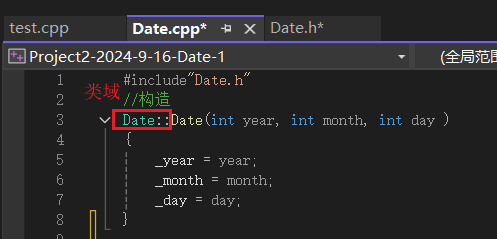
类里声明打印,实现


运算符重载<和运算符重载==
为什么要先实现这2个呢,因为实现这2个后,其他4个可以进行复用。
类里声明运算符重载<和==
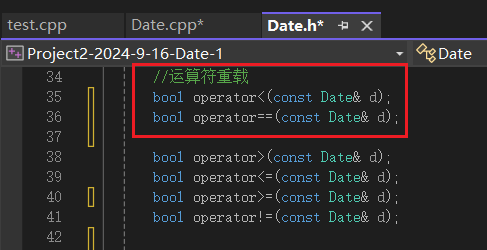
判断小于就是先,判断年,年相等就判断月,年/月相等判断天数。
//运算符重载<小于
bool Date::operator<(const Date& d)
{
//判断年
if (_year < d._year)
{
return true;
}
//年相等,判断月
else if (_year == d._year && _month < d._month)
{
return true;
}
//年相等,月相等,判断天数
else if(_year == d._year && _month == d._month && _day < d._day)
{
return true;
}
return false;
}判断相等,年月日相等,就为真。
//运算符重载==等于
bool Date::operator==(const Date& d)
{
return _year == d._year
&& _month == d._month
&& _day == d._day;
}
运算符重载进行复用
当我们实现了<和==的运算符重载,其他的就可以复用了
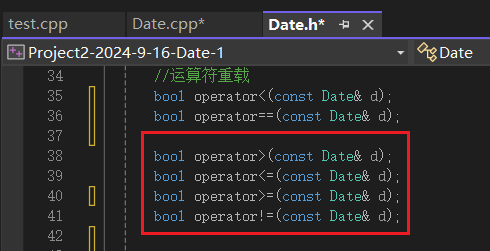
运算符重载<=
this<d会进到(运算符重载<),this==d会进到(运算符重载==)
小于d || 等于d 都为真
//运算符重载 <= 小于等于
bool Date::operator<=(const Date& d)
{
return *this < d || *this == d;
}运算符重载>=
当this小于d为真,然后!取反就为假了。
当this大于等于d为假,然后!取反就为真了。
//运算符重载 >= 大于等于
bool Date::operator>=(const Date& d)
{
return !(*this < d);
}运算符重载>
这里当this小于等于d为真,然后!取反就为假了。
如果是this大于d为假,然后!取反就为假了
//运算符重载 > 大于
bool Date::operator>(const Date& d)
{
return !(*this <= d);
}运算符重载!=
这个就是等于的取反。
//运算符重载 != 不等于
bool Date::operator!=(const Date& d)
{
return !(*this == d);
}获取某年某月的天数
这个获取某年某月的天数会频繁调用,我们就直接在类里实现,
这样就不用到类域去找了。
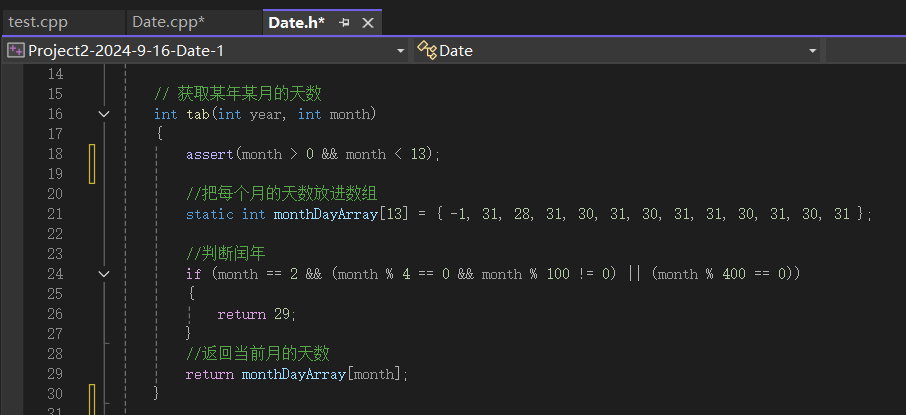
assert断言月必须是1到12月。
然后把每个月的天数放到数组里,0下标位置随便放个数字占位置。
这样每个月的下标就对应到每个月的天数了。
每次调用函数都会创建这个数组。
数组前面加个staic,出了作用域不会被销毁了,从而提高了效率。
判断闰年,月是2月,并且是闰年,返回29。
// 获取某年某月的天数
int tab(int year, int month)
{
assert(month > 0 && month < 13);
//把每个月的天数放进数组
static int monthDayArray[13] = { -1, 31, 28, 31, 30, 31, 30, 31, 31, 30, 31, 30, 31 };
//判断闰年
if (month == 2 && (month % 4 == 0 && month % 100 != 0) || (month % 400 == 0))
{
return 29;
}
//返回当前月的天数
return monthDayArray[month];
}日期+=或+天数
日期加天数,可以计算比如100天后的日期。

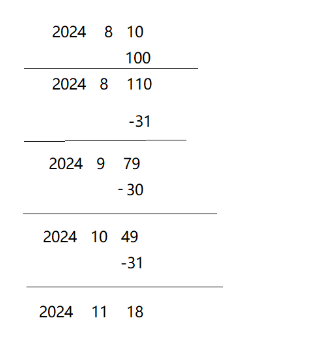
思路:日期的天数 加 n ,然后循环减去当前月的天数,每当减一次,月就+1。
月==13了,往年进1,年 + 1,然后月为来年1月了。
//日期+=天数
Date& Date::operator+=(int n)
{
//让天数 + n
_day += n;
//加完后的天数,大于当前月份的天数
while (_day > tab(_year, _month))
{
//减去当前月份的天数
_day -= tab(_year, _month);
//月 + 1
++_month;
//月 等于 13
if (_month == 13)
{
//往年进1,年 + 1
++_year;
//月为来年1月,(给月赋值1)
_month = 1;
}
}
//返回加完后的,日期类,this这个是d1,不会被销毁,所以用引用返回
return *this;
}日期+天数,把this拷贝给add,直接复用+=,让add+=n。
//日期+日期
Date Date::operator+(int n)
{
//把this拷贝给add
Date add = *this;
//让add += n
add += n;
//返回add,这个add会被销毁,不能用引用返回,所以要返回数值
return add;
}
结果:
我们可以看到,9月16日+=100天后是12月25日。

我们可以看到d1+100的日期拷贝给d2,d2变了,为什么d1没有变呢?
运算符重载+,把d1拷贝给add,add+=100,实际上d1并没有改变。
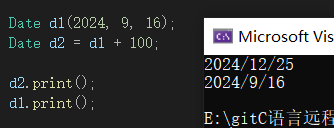
日期-=或-天数
日期-=或-天数和日期+=或+天数一样,我就不多说了。

Date& Date::operator-=(int n)
{
//让天数 - n
_day -= n;
//小于0循环加到大于0
while (_day < 0)
{
//让天数 + 当前
_day += tab(_year, _month);
//月-1
--_month;
//月减到0
if (_month == 0)
{
//年-1
--_year;
//月就是12月
_month = 12;
}
}
//返回加完后的,日期类,this这个是d1,不会被销毁,所以用引用返回
return *this;
}
前置++和后置++
我们已经实现了+=,前置++和后置++就可以+=1了。
//++d
//前置++,编译器会自动转换成 d1.operator++()
Date& operator++()
{
//使用+=运算符重载+1
*this += 1;
//返回d1引用
return *this;
}
//d++
//后置++,编译器会自动转换成 d1.operator++(0)
Date operator++(int)
{
//d1拷贝给tab
Date tab(*this);
//使用+=运算符重载+1
*this += 1;
//返回tab的值
return tab;
}
日期-日期
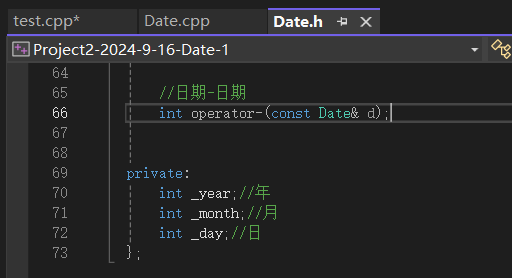
思路:先假设d1大于d2,falg = 1。
判断d1如果小于d2,把大的值给d1,小的给d2,交换过falg = -1。
天数计数器n,循环拿最小的那个d2加到和最大的d1相等,天数计数器也要跟着加。
n乘falg,正数没影响,falg是负数,n*falg就会变成负数。
//日期-日期
int Date::operator-(const Date& d)
{
//假设d1大于d2
Date d1 = *this;
Date d2 = d;
int falg = 1;
//判断,d1小于d2
if (d1 < d2)
{
//把大的值给d1,小的给d2
d1 = d;
d2 = *this;
//控制正负数
falg = -1;
}
//天数计数器
int n = 0;
//加到d2等于d1
while (d2 != d1)
{
++d2;
++n;
}
//n乘falg,正数没影响,falg是负数,n*falg就会变成负数
return n * falg;
}结果:
当前日期减去出生日期就可以得到,从出生到现在过了多少天了。

日期类实现代码
Date.h
#pragma once
#define _CRT_SECURE_NO_WARNINGS 1
#include<iostream>
#include<assert.h>
using namespace std;
class Date
{
public:
//全缺省构造函数
Date(int year = 1, int month = 1, int day = 1);
// 获取某年某月的天数
int tab(int year, int month)
{
assert(month > 0 && month < 13);
//把每个月的天数放进数组
static int monthDayArray[13] = { -1, 31, 28, 31, 30, 31, 30, 31, 31, 30, 31, 30, 31 };
//判断闰年
if (month == 2 && (month % 4 == 0 && month % 100 != 0) || (month % 400 == 0))
{
return 29;
}
//返回当前月的天数
return monthDayArray[month];
}
//打印
void print();
//运算符重载
bool operator<(const Date& d);
bool operator==(const Date& d);
bool operator>(const Date& d);
bool operator<=(const Date& d);
bool operator>=(const Date& d);
bool operator!=(const Date& d);
//日期+=或+天数
Date& operator+=(int n);
Date operator+(int n);
//日期-=或-天数
Date& operator-=(int n);
Date operator-(int n);
//前置++/后置++
Date& operator++();
Date operator++(int);
//前置--/后置--
Date& operator--();
Date operator--(int);
//日期-日期
int operator-(const Date& d);
//声明友元函数,运算符重载流插入
//流插入
friend ostream& operator<<(ostream& cout, const Date& d);
//流提取
friend istream& operator>>(istream& cin, Date& d);
private:
int _year;//年
int _month;//月
int _day;//日
};Date.cpp
#include"Date.h"
//构造
Date::Date(int year, int month, int day )
{
_year = year;
_month = month;
_day = day;
}
//打印
// Date* const this
void Date::print()
{
cout << _year << "/" << _month << "/" << _day << endl;
}
//运算符重载<小于
bool Date::operator<(const Date& d)
{
//判断年
if (_year < d._year)
{
return true;
}
//年相等,判断月
else if (_year == d._year && _month < d._month)
{
return true;
}
//年相等,月相等,判断天数
else if(_year == d._year && _month == d._month && _day < d._day)
{
return true;
}
return false;
}
//运算符重载==等于
bool Date::operator==(const Date& d)
{
return _year == d._year
&& _month == d._month
&& _day == d._day;
}
//运算符重载 > 大于
bool Date::operator>(const Date& d)
{
return !(*this <= d);
}
//运算符重载 <= 小于等于
bool Date::operator<=(const Date& d)
{
return *this < d || *this == d;
}
//运算符重载 >= 大于等于
bool Date::operator>=(const Date& d)
{
return !(*this < d);
}
//运算符重载 != 不等于
bool Date::operator!=(const Date& d)
{
return !(*this == d);
}
//Date& Date::operator=(const Date& d)
//{
// _year = d._year;
// _month = d._month;
// _day = d._day;
// return *this;
//}
//日期+=日期
Date& Date::operator+=(int n)
{
//让天数 + n
_day += n;
//加完后的天数,大于当前月份的天数
while (_day > tab(_year, _month))
{
//减去当前月份的天数
_day -= tab(_year, _month);
//月 + 1
++_month;
//月 等于 13
if (_month == 13)
{
//往年进1,年 + 1
++_year;
//月为来年1月,(给月赋值1)
_month = 1;
}
}
//返回加完后的,日期类,this这个是d1,不会被销毁,所以用引用返回
return *this;
}
//日期+日期
Date Date::operator+(int n)
{
//把this拷贝给add
Date add = *this;
//让add天数 += n
add += n;
//返回add,这个add会被销毁,不能用引用返回,所以要返回数值
return add;
}
Date& Date::operator-=(int n)
{
//让天数 - n
_day -= n;
//小于0循环加到大于0
while (_day < 0)
{
//让天数 + 当前
_day += tab(_year, _month);
//月-1
--_month;
//月减到0
if (_month == 0)
{
//年-1
--_year;
//月就是12月
_month = 12;
}
}
//返回加完后的,日期类,this这个是d1,不会被销毁,所以用引用返回
return *this;
}
Date Date::operator-(int n)
{ //把this拷贝给add
Date add = *this;
//让add天数 -= n
add._day -= n;
//返回add,这个add会被销毁,不能用引用返回,所以要返回数值
return add;
}
//前置++
Date& Date::operator++()
{
*this += 1;
return *this;
}
//后置++
Date Date::operator++(int)
{
Date tab(*this);
*this += 1;
return tab;
}
//前置--
Date& Date::operator--()
{
*this -= 1;
return *this;
}
//后置--
Date Date::operator--(int)
{
Date tab(*this);
*this -= 1;
return tab;
}
//日期-日期
int Date::operator-(const Date& d)
{
//假设d1大于d2
Date d1 = *this;
Date d2 = d;
int falg = 1;
//判断,d1小于d2
if (d1 < d2)
{
//把大的值给d1,小的给d2
d1 = d;
d2 = *this;
//控制正负数
falg = -1;
}
//天数计数器
int n = 0;
//加到d2等于d1
while (d2 != d1)
{
++d2;
++n;
}
//n乘falg,正数没影响,falg是负数,n*falg就会变成负数
return n * falg;
}
//流插入
ostream& operator<<(ostream& cout, const Date& d)
{
cout << d._year << "年" << d._month << "月" << d._day << endl;
return cout;
}
//流提取
istream& operator>>(istream& cin, Date& d)
{
cin >> d._year >> d._month >> d._day;
return cin;
}
test.cpp
#include"Date.h"
//int main()
//{
// //Date d1(2024, 8, 10);
// //d1.print();
// //Date d2 = (d1 + 100);
// //d1 += 100;
// //d1.print();
// //d1 -= 100;
// //d1.print();
// //d1 -= 100;
// //d1.print();
//
// Date d1(2024, 9, 21);
// Date d2(2006, 3, 5);
// cout << d1 - d2 << endl;
//}
int main()
{
Date d1;
Date d2;
Date d3;
//流提取
cin >> d1 >> d2 >> d3;
//流插入
cout << d1 << d2 << d3 << endl;
}
运算符重载的(流插入和流提取)
重载<<和>>时,需要重载为全局函数,因为重载为成员函数,this指针默认抢占了第⼀个形参位置,第⼀个形参位置是左侧运算对象,调⽤时就变成了 对象<<cout,不符合使⽤习惯和可读性。重载为全局函数把ostream/istream放到第⼀个形参位置就可以了,第⼆个形参位置当类类型对象。
流插入
cout是ostream类型的对象
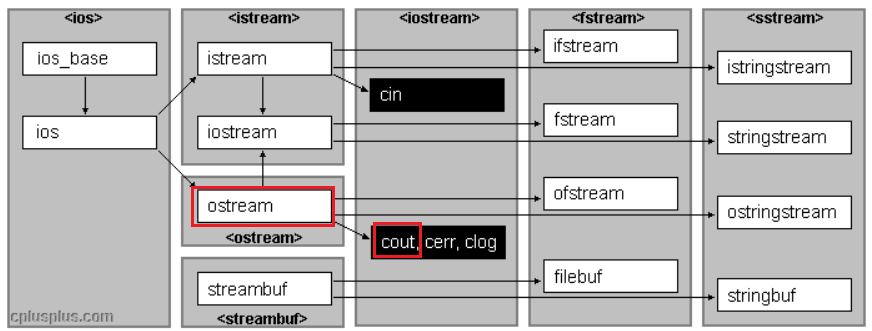
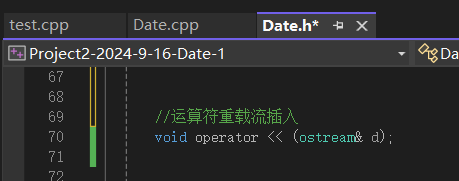
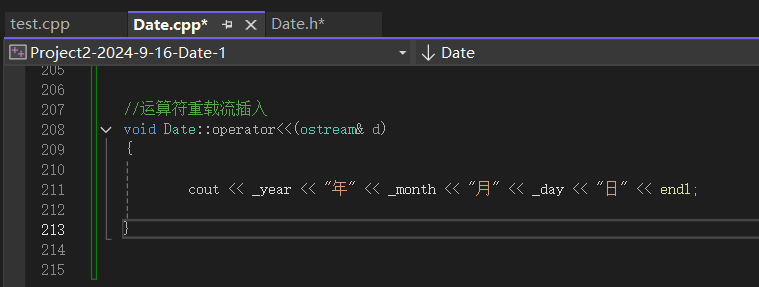
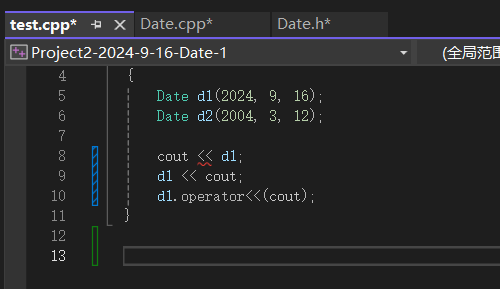
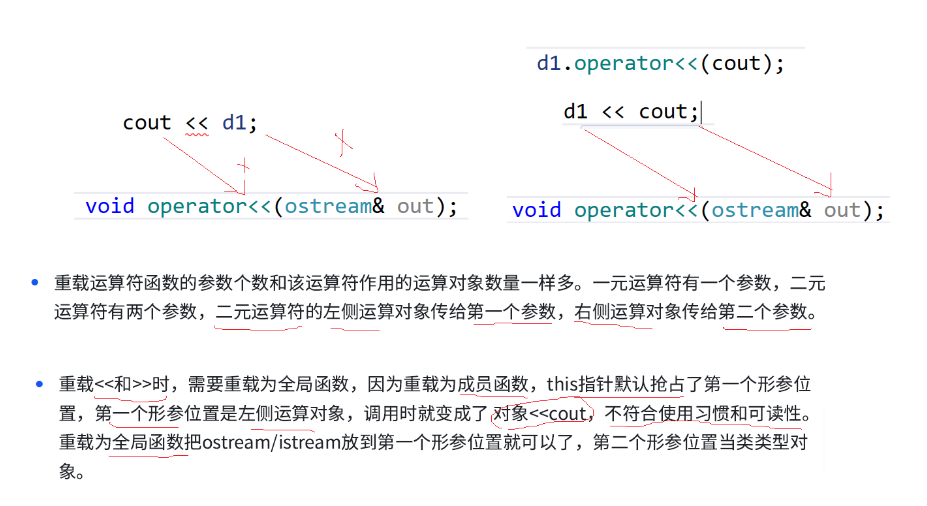
调⽤时就变成了对象<<cout,不符合使⽤习惯和可读性。
所以我们需要重载为全局函数把ostream/istream放到第⼀个形参位置就可以了,第⼆个形参位置当类类型对象。
重载为全局函数,就访问不了私有成员了,有2个方法可以解决
1.把成员变量公有。
2.用友元函数。
友元函数类和对象下会讲,这里我们先用。
友元函数可以在成员函数里声明,也可以在成员变量声明。
这里是把d插入到流cout,所以d不用改变,前面加个const。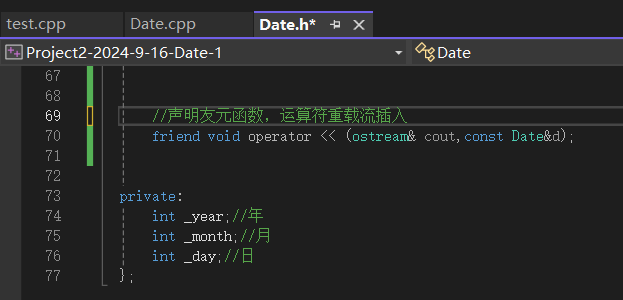
把d的成员变量插入流cout

这样的可读性就变好起来了 。
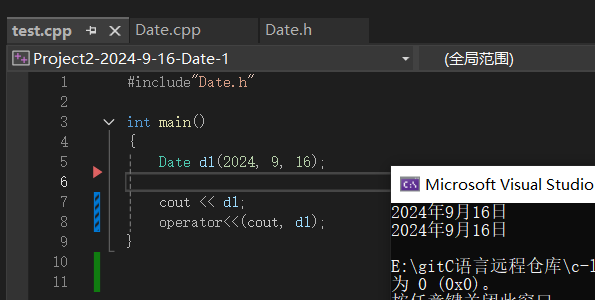

当我们连续插入流就不行了。
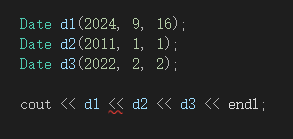
当d1插入流的时候,流返回,d2再插入流,流必须要返回才能连续插入流。
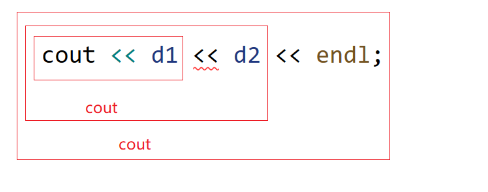
引用返回ostream流,因为出了作用域cout还在。
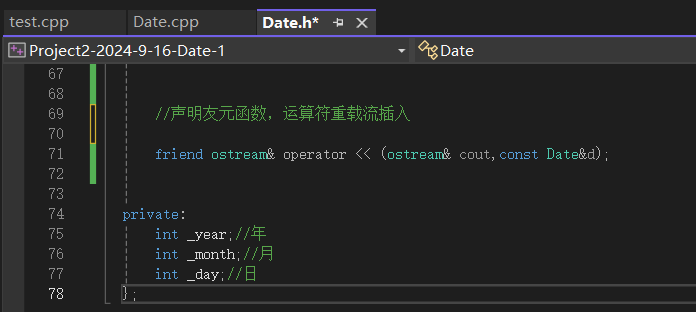 返回cout
返回cout

我们可以看到连续插入了3个日期。
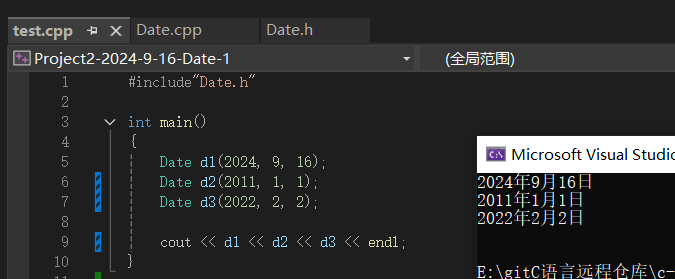
流提取
cin是istream类型的对象


流提取,提取我们从键盘输入的数据,写入日期里。


取地址运算符重载
const成员函数
- 将const修饰的成员函数称之为const成员函数,const修饰成员函数放到成员函数参数列表的后⾯。
- const实际修饰该成员函数隐含的this指针指向的内容,表明在该成员函数中不能对类的任何成员进⾏修改。const 修饰Date类的Print成员函数,Print隐含的this指针由 Date* const this 变为 const Date* const this

隐含的this指针,都会有const修饰本身

当我们const修饰了d2,我们不希望d2的内容被修改。
这个const修饰的d2,内容不能被修改。
传给this指针,它前面没有const修饰,d2传给this指针,那岂不是可以修改d2的内容。
那这不就是权限放大吗。(会报错)

要给this前面加const,我们就在函数后面加const就可以了。
![]()
在函数后面加const,就相当于加在了 * 号前面的位置。

加了const修饰之后,this指针也不能对,成员变量的内容进行修改了。
d1这种,没有被const修饰,传给被const修饰的this指针,就是一种权限的缩小了。



结果:
我们可以看到都可以正常运行。


代码:
#include<iostream>
using namespace std;
class Date
{
public:
Date(int year = 1, int month = 1, int day = 1)
{
_year = year;
_month = month;
_day = day;
}
// void Print(const Date* const this) const
void Print() const
{
cout << _year << "-" << _month << "-" << _day << endl;
}
private:
int _year;
int _month;
int _day;
};
int main()
{
// 这⾥⾮const对象也可以调⽤const成员函数是⼀种权限的缩⼩
Date d1(2024, 7, 5);
d1.Print();
const Date d2(2024, 8, 5);
d2.Print();
return 0;
}取地址运算符重载
取地址运算符重载分为普通取地址运算符重载和const取地址运算符重载,⼀般这两个函数编译器⾃动⽣成的就可以够我们⽤了,不需要去显⽰实现。除⾮⼀些很特殊的场景,⽐如我们不想让别⼈取到当前类对象的地址,就可以⾃⼰实现⼀份,胡乱返回⼀个地址。
一个是取普通对象的地址,一个是取const修饰的对象地址。
这2个运算符重载,我们不需要自己实现,编译器默认生成的就够用了。
除⾮⼀些很特殊的场景,如果我们不希望返回它的地址,可以显示写,返回nullptr。


